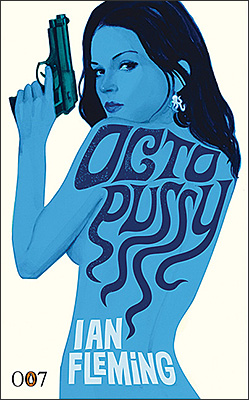|
Ian Fleming's Octopussy and The Living Daylights

'For James Bond, British secret agent 007, international
espionage can be a dirty business. Whether it is tracking down a
wayward Major who has taken a deadly secret with him to the Caribbean;
identifying a top Russian agent secretly bidding for a Fabergé
egg in a Sotheby’s auction room; or ruthlessly gunning down an
unlikely assassin in sniper’s alley between East and West Berlin,
Bond always closes the case - with extreme prejudice.'
Octopussy and The Living Daylights is the fourteenth and final James
Bond book by Ian Fleming and was published posthumously in 1966. There
are four stories in this slim volume - two of which were added in later
additions. The first story is called Octopussy. A murder victim called
Hans Oberhauser is found frozen in an Austrian glacier and James Bond
is sent to Jamaica to talk to the last man to see the victim before his
death. This just happens to be a certain Major Dexter Smythe. Bond is
personally involved in the case as Oberhauser was a mentor to him in
his younger days after the death of his parents. 'It just happened that
Oberhauser was a friend of mine. He taught me to ski before the war,
when I was in my teens. He was a wonderful man. He was something of a
father to me at a time when I happened to need one.'
Bond suspects Smythe had something to do with the murder but Smythe is
also a former Royal Marine with a distinguished service record. Can 007
get to the truth of what happened all those years ago? Octopussy is a
modestly interesting story with a plot involving a cache of Nazi gold
and some typically Flemingesque descriptions of rare fish and undersea
creatures. 'The octopus explored his right hand with its buccal
orifice... ' The main problem with Octopussy though is that Bond is
rather incidental to the story and only appears briefly, the story told
by Dexter Smythe as a flashback. This doesn't bear much resemblance to
the 1983 Roger Moore film save for Dexter Smythe having a pet
'Octopussy' and his story and fate becoming that of Octopussy's father
in the film. There are a few good flourishes here though even if this
isn't terribly inspiring.
The second story is called The Property of a Lady. A communications
clerk with British Intelligence called Maria Freudenstein is a double
agent working for the Soviets. M has been on to Freudenstein for ages
though and feeds her false information but he is curious to see what
her reward from the Russians will be as she doesn't seem to have much
in the bank beyond her clerk's salary. When Freudenstein suspiciously
'inherits' a Fabergé egg to auction at Sotheby's, Bond points
out that a major KGB figure will have to be secretly present to bid for
it and therefore push the price up to cover her services to them. Bond
duly attends the auction to look for the KGB representative. A decent
story but nothing special, The Property of a Lady was incorporated into
the previously mentioned 1983 Roger Moore film Octopussy where Moore's
Bond visited Sotheby's to observe the bidding for a Fabergé egg.
This isn't bad but like the first story Octopussy is hardly essential.

The third story is called The Living Daylights. A British agent known
as '272' is heading back to the West through Berlin and the Soviets are
sending their top assassin - codenamed 'Trigger' - to shoot him as he
makes his way across no-man's land. M sends James Bond to kill the KGB
assassin and 007 hunkers down in a safe house with his sniper rifle
waiting for a shot at his target, watching what appears to be a female
orchestra go in and out of the building he is keeping watch on. The
Living Daylights is an interesting story and the strongest one here. It
revolves around Bond's distaste for killing - despite it often being
his job. This story was incorporated into the beginning of the 1987
Timothy Dalton film of the same name in (for the film series) faithful
fashion and presents us with a more weary, tired Bond who is
questioning his profession and the things he has to do in the name of
Queen and Country. There is a decent twist here when the target is
revealed and the main drama comes from Bond's reaction to what he has
been asked to do.
The final short story is called 007 in New York and is by far the
shortest of the four on offer here. The story first appeared in US
editions of Fleming's non-fiction book Thrilling Cities which collected
some travel pieces he had written for the Sunday Times. In this story
James Bond is sent to New York to tell a former MI6 secretary that the
man she lives with is a KGB agent. This secret trip by 007 is a
courtesy afforded to her by M for loyal service in the past. Bond
arranges to meet her at Central Park Zoo and thinks about a woman
called Solange who he will also see later. 007 in New York is a mildly
interesting trifle that consists of Bond's general musings about New
York and also a lot about food and where he will go to eat. Martinis at
the Plaza and dinner at Grand Central's Oyster Bar etc. This story is
most enjoyable perhaps for including Bond's theory on perfect scrambled
eggs.
'Break the eggs into a bowl. Beat thoroughly with a fork and season
well. In a small copper (or heavy bottomed saucepan) melt four oz. of
the butter. When melted, pour in the eggs and cook over a very low
heat, whisking continuously with a small egg whisk. While the eggs are
slightly more moist than you would wish for eating, remove the pan from
heat, add rest of butter and continue whisking for half a minute,
adding the while finely chopped chives or fines herbes. Serve on hot
buttered toast in individual copper dishes (for appearance only) with
pink champagne (Taittinger) and low music.'
Octopussy and The Living Daylights is not a tremendously memorable
collection of stories and far from the best example of Ian Fleming's
work. The Living Daylights is a solid entry though and there is just
enough to keep Bond fans relatively entertained. Not bad but the For
Your Eyes Only short story collection was undoubtedly stronger.
- Jake
c
2010
Alternative 007
|

|


